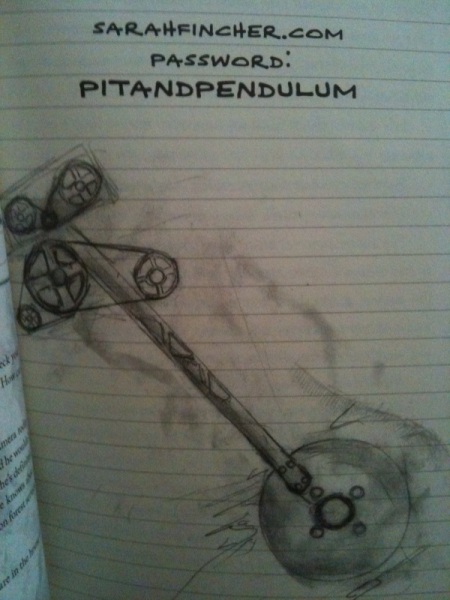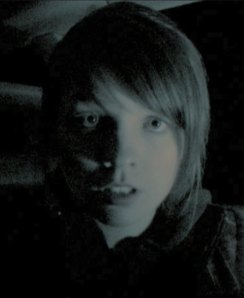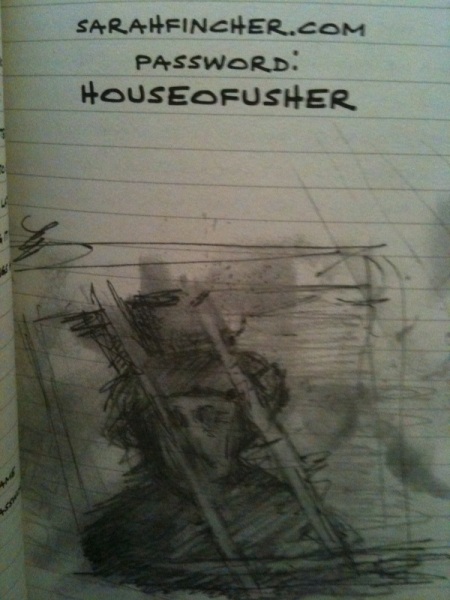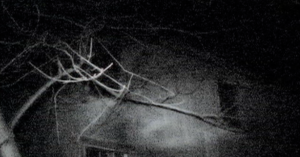 Theraven’ analysis.
Theraven’ analysis.
The second password that appears on page 38 in Skeleton Creek, ‘theraven,’ is the second Edgar Allen Poe reference that we are given. Similar to the ‘houseofusher’ I strongly believe that this password holds significant meaning, something that deserves being discussed and debated. I hope to accomplish that here by asking ‘why?’
Very little analysis would be possible without first analyzing the poem itself. For those of you who aren’t as familiar with the poem, I’ve gone ahead and posted it.
The Raven
Once upon a midnight dreary, while I pondered, weak and weary,
Over many a quaint and curious volume of forgotten lore,
While I nodded, nearly napping, suddenly there came a tapping,
As of some one gently rapping, rapping at my chamber door.
“‘Tis some visitor,” I muttered, “tapping at my chamber door –
Only this, and nothing more.”
Ah, distinctly I remember it was in the bleak December,
And each separate dying ember wrought its ghost upon the floor.
Eagerly I wished the morrow; – vainly I had sought to borrow
From my books surcease of sorrow – sorrow for the lost Lenore –
For the rare and radiant maiden whom the angels name Lenore –
Nameless here for evermore.
And the silken sad uncertain rustling of each purple curtain
Thrilled me – filled me with fantastic terrors never felt before;
So that now, to still the beating of my heart, I stood repeating,
“‘Tis some visitor entreating entrance at my chamber door –
Some late visitor entreating entrance at my chamber door; –
This it is, and nothing more.”
Presently my soul grew stronger; hesitating then no longer,
“Sir,” said I, “or Madam, truly your forgiveness I implore;
But the fact is I was napping, and so gently you came rapping,
And so faintly you came tapping, tapping at my chamber door,
That I scarce was sure I heard you”- here I opened wide the door; –
Darkness there, and nothing more.
Deep into that darkness peering, long I stood there wondering, fearing,
Doubting, dreaming dreams no mortals ever dared to dream before;
But the silence was unbroken, and the stillness gave no token,
And the only word there spoken was the whispered word, “Lenore?”
This I whispered, and an echo murmured back the word, “Lenore!” –
Merely this, and nothing more.
Back into the chamber turning, all my soul within me burning,
Soon again I heard a tapping somewhat louder than before.
“Surely,” said I, “surely that is something at my window lattice:
Let me see, then, what thereat is, and this mystery explore –
Let my heart be still a moment and this mystery explore; –
‘Tis the wind and nothing more.”
Open here I flung the shutter, when, with many a flirt and flutter,
In there stepped a stately raven of the saintly days of yore;
Not the least obeisance made he; not a minute stopped or stayed he;
But, with mien of lord or lady, perched above my chamber door –
Perched upon a bust of Pallas just above my chamber door –
Perched, and sat, and nothing more.
Then this ebony bird beguiling my sad fancy into smiling,
By the grave and stern decorum of the countenance it wore.
“Though thy crest be shorn and shaven, thou,” I said, “art sure no craven,
Ghastly grim and ancient raven wandering from the Nightly shore –
Tell me what thy lordly name is on the Night’s Plutonian shore!”
Quoth the Raven, “Nevermore.”
Much I marvelled this ungainly fowl to hear discourse so plainly,
Though its answer little meaning- little relevancy bore;
For we cannot help agreeing that no living human being
Ever yet was blest with seeing bird above his chamber door –
Bird or beast upon the sculptured bust above his chamber door,
With such name as “Nevermore.”
But the raven, sitting lonely on the placid bust, spoke only
That one word, as if his soul in that one word he did outpour.
Nothing further then he uttered- not a feather then he fluttered –
Till I scarcely more than muttered, “other friends have flown before –
On the morrow he will leave me, as my hopes have flown before.”
Then the bird said, “Nevermore.”
Startled at the stillness broken by reply so aptly spoken,
“Doubtless,” said I, “what it utters is its only stock and store,
Caught from some unhappy master whom unmerciful Disaster
Followed fast and followed faster till his songs one burden bore –
Till the dirges of his Hope that melancholy burden bore
Of ‘Never – nevermore’.”
But the Raven still beguiling all my fancy into smiling,
Straight I wheeled a cushioned seat in front of bird, and bust and door;
Then upon the velvet sinking, I betook myself to linking
Fancy unto fancy, thinking what this ominous bird of yore –
What this grim, ungainly, ghastly, gaunt and ominous bird of yore
Meant in croaking “Nevermore.”
This I sat engaged in guessing, but no syllable expressing
To the fowl whose fiery eyes now burned into my bosom’s core;
This and more I sat divining, with my head at ease reclining
On the cushion’s velvet lining that the lamplight gloated o’er,
But whose velvet violet lining with the lamplight gloating o’er,
She shall press, ah, nevermore!
Then methought the air grew denser, perfumed from an unseen censer
Swung by Seraphim whose footfalls tinkled on the tufted floor.
“Wretch,” I cried, “thy God hath lent thee – by these angels he hath sent thee
Respite – respite and nepenthe, from thy memories of Lenore:
Quaff, oh quaff this kind nepenthe and forget this lost Lenore!”
Quoth the Raven, “Nevermore.”
“Prophet!” said I, “thing of evil! – prophet still, if bird or devil! –
Whether Tempter sent, or whether tempest tossed thee here ashore,
Desolate yet all undaunted, on this desert land enchanted –
On this home by horror haunted- tell me truly, I implore –
Is there – is there balm in Gilead? – tell me – tell me, I implore!”
Quoth the Raven, “Nevermore.”
“Prophet!” said I, “thing of evil – prophet still, if bird or devil!
By that Heaven that bends above us – by that God we both adore –
Tell this soul with sorrow laden if, within the distant Aidenn,
It shall clasp a sainted maiden whom the angels name Lenore –
Clasp a rare and radiant maiden whom the angels name Lenore.”
Quoth the Raven, “Nevermore.”
“Be that word our sign in parting, bird or fiend,” I shrieked, upstarting –
“Get thee back into the tempest and the Night’s Plutonian shore!
Leave no black plume as a token of that lie thy soul hath spoken!
Leave my loneliness unbroken!- quit the bust above my door!
Take thy beak from out my heart, and take thy form from off my door!”
Quoth the Raven, “Nevermore.”
And the Raven, never flitting, still is sitting, still is sitting
On the pallid bust of Pallas just above my chamber door;
And his eyes have all the seeming of a demon’s that is dreaming,
And the lamplight o’er him streaming throws his shadow on the floor;
And my soul from out that shadow that lies floating on the floor
Shall be lifted – nevermore!
There are certain elements to the poem that are important to this discussion, but there is no need to discuss things like rhyme and meter. The use of trochaic octameter has no bearing on its placement in Skeleton Creek. That being said, there is plenty in this poem that speaks volumes to Skeleton Creek and the characters we follow. In the poem, the raven sits upon a bust (statue) of Pallas, a symbol of wisdom. Through small details like this, we learn that the narrator is a young scholar, something that he has in common with our two main characters from Skeleton Creek.
“The Raven” is famous for being this piece that Poe claimed to have written very methodically, logically. When delicate art is presented as something that can be well thought out, planned, and premeditated I begin to become suspicious. I prefer to think of poetry as a spontaneous pursuit, organic in its roots. Are we to assume that Sarah has been doing the same with her own art?
These videos that she produces, what purpose are they serving? When I watch these videos I am watching from Ryan’s perspective, as if a friend had sent me some urgent message to help pass along useful information. But the possibility exists that Sarah isn’t the kind of friend Ryan believes her to be. The possibility exists that these videos are premeditated attempts to scare Ryan into relying on Sarah for more information. He begins to use her as a crutch, his primary source of investigative information. Sarah knows all this, so tampering with the story and the evidence would be well within her abilities.
If you continue with this theory you begin to see more connections. The narrator in “The Raven” understands and is completely aware of the fact that the raven can only speak the word ‘nevermore’. However, that doesn’t stop him from questioning the bird. As a third party, we get to see this play out: the narrator prods the raven to tell him more but being conscious of the situation he knows that he can anticipate the answers. This is a strong reflection of Sarah’s relationship with Ryan. She sends these videos knowing exactly how he’ll react, providing her the ability to treat their relationship as a game of chess, always 3 steps ahead. She’s anticipating his fear and paranoia, playing off of it, all the while pushing him in the direction she wants him to go.
This would all be conjecture without providing motive, but motive isn’t a stretch in this case. Sarah loves the idea that Ryan relies on her and by pushing his buttons she can play off his anxiety, his paranoia, and convince him that she’s the only one who can help. People with power want only one thing; more power. If this is the case, we would be able to see that in the videos. If we step out of Ryan’s shoes and become a non-committed viewer able to provide unbiased analysis, would we see that Sarah’s videos are skewed to create fear where there is nothing? This poem shows us just how much we can potentially learn about Sarah’s character by how she relays information through her videos.







